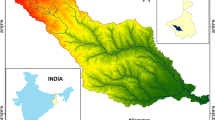Abstract
A study on land degradation in the upper catchment of river Tons, a tributary of Yamuna river, in Uttarkashi district of the Uttarakhand state, was carried out using on-screen visual interpretation of IRS LISS-III + PAN merged data. The study area, which is largely mountainous, includes Govind Wildlife Sanctuary and National Park. Vegetation cover, slope and erosion status were used as criteria for the delineation of four major land degradation categories viz., undegraded, moderately degraded, degraded and severely degraded. More than 50 per cent of the study area is reported to be covered with snow and grassland. The moderate to severely degraded area worked out to be 42.4 per cent of the total area. The 32.8 per cent of area was found to be moderately degraded, followed by degraded (6.63%) and severely degraded (2.88%) areas. The depletion of vegetation cover on mountainous terrain and subsequent cultivation without proper protection measures is the reason for severe soil erosion and land degradation. In view of the existing land degradation situation, the catchment requires immediate treatment on priority for the sustenance of agriculture and wild life. It is expected that these measures will reduce the silt load in the river Tons and eventually, in river Yamuna.
Similar content being viewed by others
References
Blaikie P and Brookfield H (1987) Land Degradation and Society. London: Methuen
Boyed DS, Foody GM, Curran PJ, Lucas RM and Honzak M (1996) An assessment of radiance in Landsat TM middle and thermal infrared wavebands for the detection of tropical forest regeneration. International Journal of Remote Sensing 17: 249–261
Champion HG and Seth SK (1968) Revised Survey of Forest Types of India. Government of India Press, New Delhi
Chisholm A and Dumsday R (1987) Land Degradation: Problems and Policies. London: Cambridge University Press
DAC (1994) Draft report on status of Land Degradation in India. Department of Agriculture and Co-operation
Dregne HE (1986) Extension and distribution of desertification processes. In: Reclamation of Arid Territories and combating desertification- A comprehensive approach, CIP, Moscow, 10–16
Koohafkan AP (2000) Land resource potential and sustainable land management. In: Advances in Land Resource management for 21st Century. Soil Conservation Society of India, New Delhi, pp 1–22
Malingreau JP, Achard F and Estreguil C (1996) NOAA AVHRR based tropical forest mapping for south-east Asia, validated and calibrated with higher spatial resolution imagery. Advances in the use of NOAA AVHRR Data for Land applications. (Eds GD Souza, AS Belward and JP Malingreau) ECSC, EEC, EAEC, Brussels and Luxembourg, Printed in the Netherlands, pp 279–310
NRSA (1995) Study of land degradation problems in Sharda Sahayak Command area for sustainable agriculture development, project report, NRSA, Hyderabad, India
Parmananda (1998) Management Plan of Govind Wildlife Sanctuary and National Park (1999–2000 to 2008–2009). Forest Department, Uttar Pradesh
Rao BRM, Dwivedi RS, Venkataratnam L, Ravisankar T, Thammappa SS, Bhargawa GP. and Singh AN (1991) Mapping the magnitude of sodicity in part of Indogangetic plains of Uttar Pradesh, using Landsat-TM data. International Journal of Remote Sensing 12(3): 419–425
UNEP (1992) United Nations Environment Program. http://www.ag.Arizona.edu./ulmilich/desrtif.html
Venkataratnam L (1989) Land Degradation and remote sensing (presented). Discussion meet organized by INSA (SCOPE) & NRSA Hyderabad. Published in Land and Soils, Har-Anand Publications, New Delhi, pp 109–127
Venkataratnam L and Rao KR (1977) Computer aided classification and mapping soils and soil limitations using Landsat multispectral data. In: Proceeding of the Symposium: Remote Sensing for Hydrology, Agriculture and Mineral Resources, Space Application Centre, Ahmedabad, pp 101–104
Venkataratnam L and Ravisankar T (1992) Digital analysis of Landsat TM data for assessing degraded lands in ‘Remote sensing applications and Geographical Information Systems- Recent Trends’, Published by Tata McGraw Hill Publishing Company Ltd., New Delhi, pp 87–90
Author information
Authors and Affiliations
Corresponding author
About this article
Cite this article
Krishan, G., Kushwaha, S.P.S. & Velmurugan, A. Land degradation mapping in the upper catchment of river Tons. J Indian Soc Remote Sens 37, 119–128 (2009). https://doi.org/10.1007/s12524-009-0003-0
Received:
Accepted:
Published:
Issue Date:
DOI: https://doi.org/10.1007/s12524-009-0003-0




